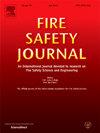Evaluating the impact of testing conditions on intumescent coatings' fire performance: A comparison of laboratory-scale and industrial-scale experiments
IF 3.4
3区 工程技术
Q2 ENGINEERING, CIVIL
引用次数: 0
Abstract
Steel is extensively utilized in construction but loses mechanical strength at elevated temperatures, posing a risk of structural failure during fires. Fire protection measures, such as intumescent coatings, are essential to ensure safe evacuation times. Regulatory standards necessitate fire testing of materials using defined fire curves in industrial furnaces, which are energy-intensive, costly, and time-consuming. To mitigate these issues, laboratory-scale (lab-scale) methods are employed to reduce costs and enhance efficiency. However, lab-scale tests, typically conducted on flat plate samples, may not accurately represent conditions in industrial furnaces. Therefore, it is imperative to systematically assess the discrepancies in intumescent coating performance between lab-scale and industrial-scale environments. This study aims to examine the influence of various testing conditions on the fire performance of intumescent coatings by comparing results from lab-scale and industrial-scale tests with two different fire scenarios, namely the hydrocarbon and cellulosic fire curves. It is shown that lab-scale flat plates closely resemble the exterior of H-columns and hollow structures. Additionally, a good agreement in expansion ratios between the exterior of H-column and hollow structures was achieved in the lab-scale tests. Replicating the thermal conditions and higher coating expansions inside the H-column web is however more challenging with flat plate lab-scale experiments.
评估测试条件对膨胀涂料防火性能的影响:实验室规模实验与工业规模实验的比较
钢在建筑中被广泛使用,但在高温下会失去机械强度,在火灾中会造成结构破坏的风险。防火措施,如膨胀涂层,对于确保安全疏散时间至关重要。监管标准要求在工业炉中使用规定的火灾曲线对材料进行火灾测试,这是能源密集型、昂贵且耗时的。为了缓解这些问题,采用实验室规模(实验室规模)的方法来降低成本和提高效率。然而,实验室规模的测试,通常在平板样品上进行,可能不能准确地代表工业炉的条件。因此,有必要系统地评估实验室规模和工业规模环境下膨胀涂层性能的差异。本研究旨在通过比较实验室规模和工业规模的测试结果,在两种不同的火灾场景下,即碳氢化合物和纤维素的火灾曲线,研究各种测试条件对膨胀涂料防火性能的影响。结果表明,实验室规模的平板与h柱和空心结构的外观非常相似。此外,在实验室规模的试验中,h柱外部与空心结构之间的膨胀比达到了很好的一致性。然而,在平板实验室规模的实验中,复制h柱腹板内部的热条件和更高的涂层膨胀率更具挑战性。
本文章由计算机程序翻译,如有差异,请以英文原文为准。
求助全文
约1分钟内获得全文
求助全文
来源期刊

Fire Safety Journal
工程技术-材料科学:综合
CiteScore
5.70
自引率
9.70%
发文量
153
审稿时长
60 days
期刊介绍:
Fire Safety Journal is the leading publication dealing with all aspects of fire safety engineering. Its scope is purposefully wide, as it is deemed important to encourage papers from all sources within this multidisciplinary subject, thus providing a forum for its further development as a distinct engineering discipline. This is an essential step towards gaining a status equal to that enjoyed by the other engineering disciplines.
 求助内容:
求助内容: 应助结果提醒方式:
应助结果提醒方式:


